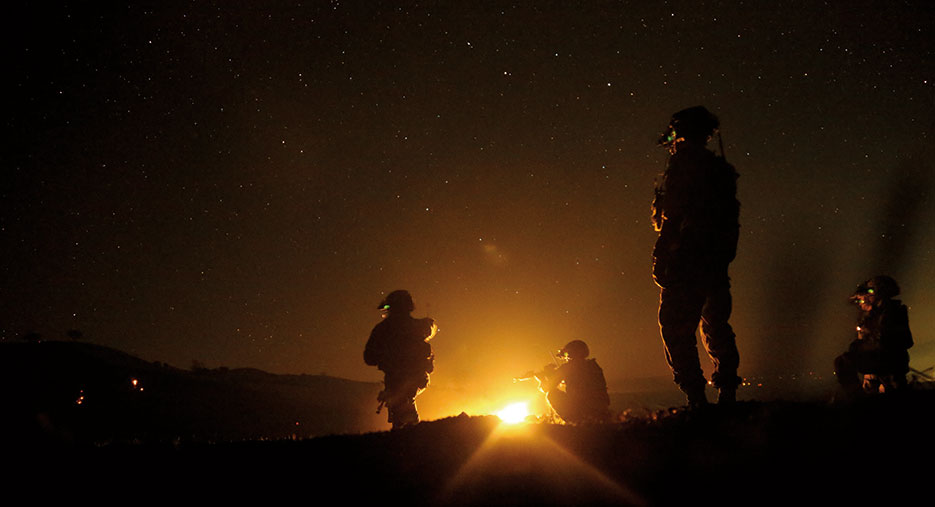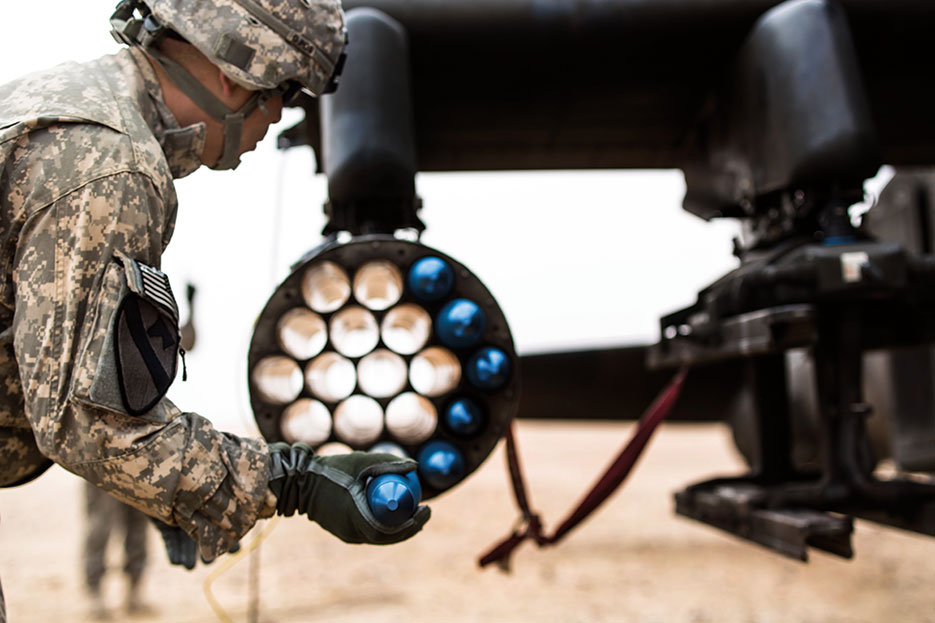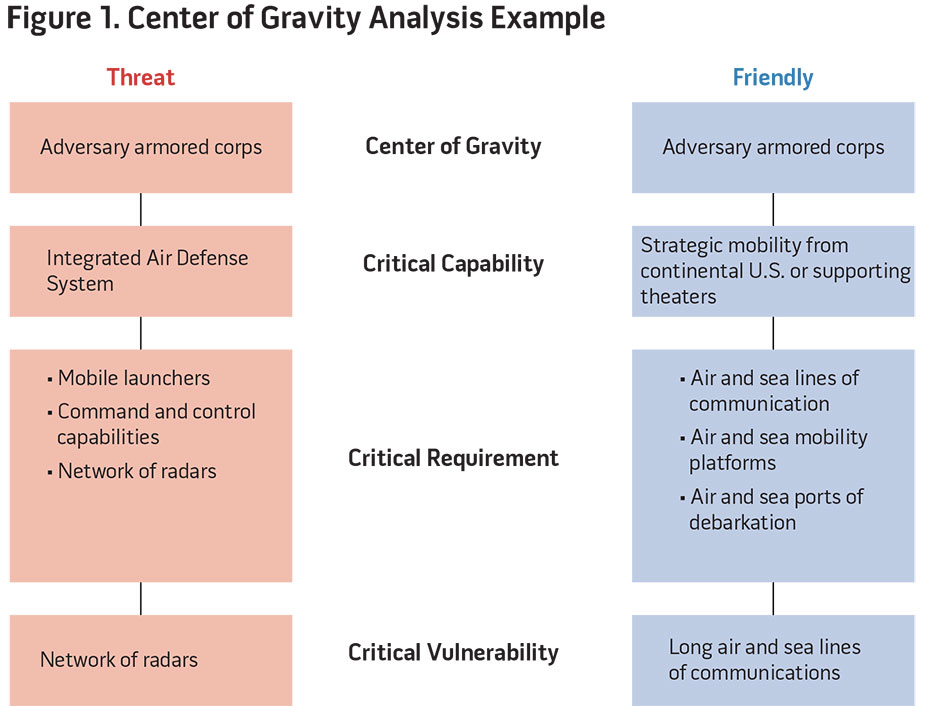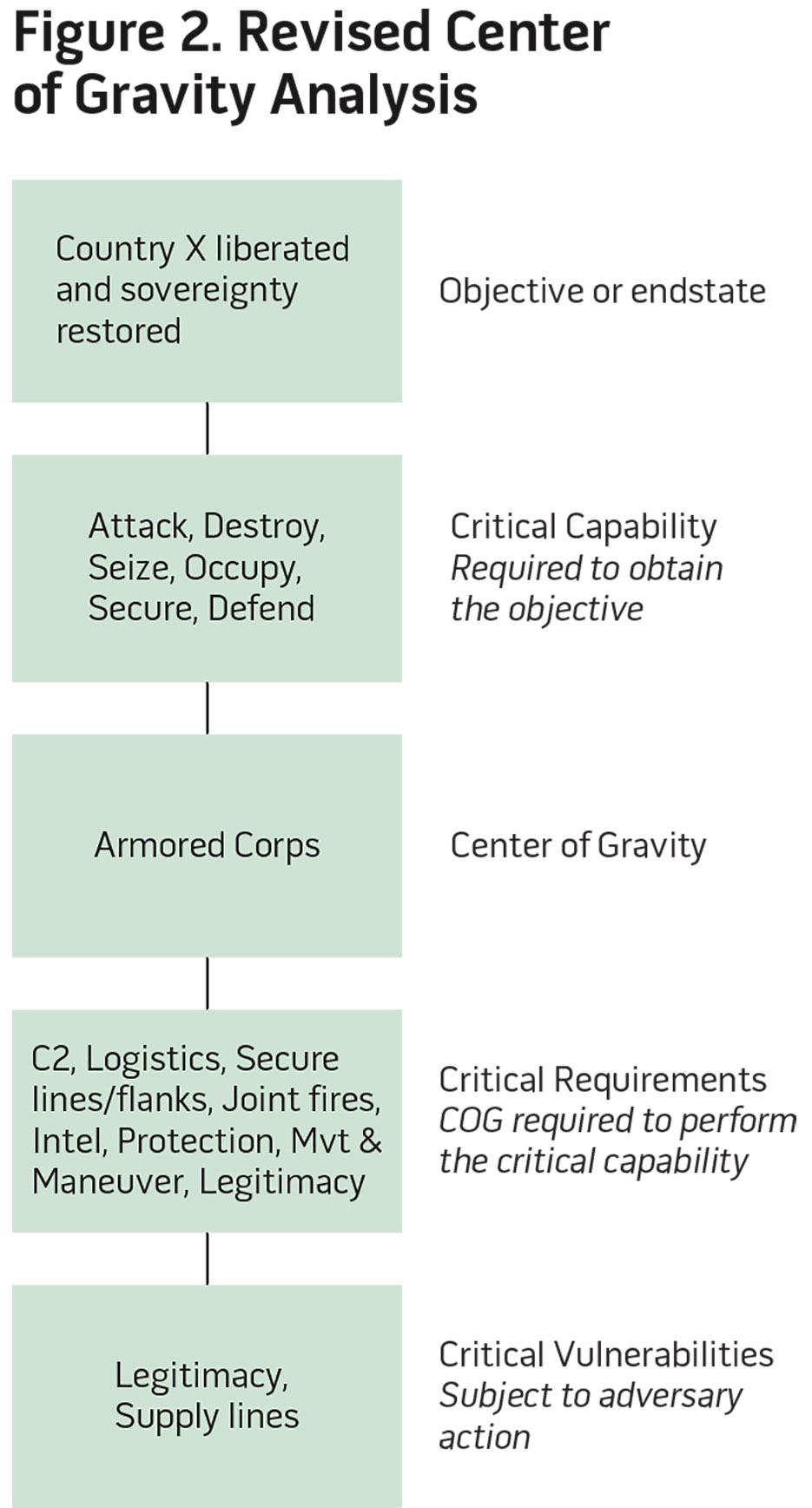Colonel Dale C. Eikmeier, USA (Ret.), is an Assistant Professor in the Department of Joint and Multinational Operations at the U.S. Army Command and General Staff College.
The current revision of Joint Publication (JP) 5-0, Joint Operation Planning, provides an opportunity to fix the flawed description of the center of gravity (COG) concept. The description is constructed so poorly that it has fueled endless debate and created volumes of articles and papers—all for something that is supposed to be clearly understood and accepted as the “linchpin in the planning effort.”1 This article proposes a new COG definition that moves away from a Clausewitzian foundation toward a modern 21st-century concept that can end years of debate and let the concept become the useful tool doctrine intended.
The main flaws fueling the doctrinal concept’s debate are its Clausewitzian foundation and its use of imprecise metaphors. When we use metaphors to define something, we do not really understand it. This imprecision, first introduced in Army doctrine in 1986 and joint doctrine in 1994, created a cottage industry of theoretical debate that rages on to this day.2 This debate has three camps: the Clausewitzian traditionalists, the rejectionists, and between them, the accommodators, who are perhaps a bit quixotic in their quest to fix the concept.

Danish soldier rushes objective during live-fire exercise at Joint Multinational Training Command’s Grafenwoehr Training Area in Germany, July 4, 2014 (DOD/Markus Rauchenberger)
The Clausewitzian traditionalists, best represented by Antulio Echevarria II of the U.S. Army War College, have sought to correct the doctrine’s flaws by going back to Carl von Clausewitz himself and his seminal On War, often in the original German, and trying to divine what he really meant. Echevarria confirmed this, stating, “Yet after more than two decades of controversy, the meaning of center of gravity remains unsettled. Fortunately some of the confusion can be eliminated by returning to its original [Clausewitz] sense.”3 The traditionalist argument is that flawed English translations corrupted the original concept and doctrine accepted this corruption, fueling the debate. Echevarria’s Naval War College Review article, “Clausewitz’s Center of Gravity: It’s Not What We Thought,” discusses this mistranslation argument. The solution, according to the author, is “to align the definitions of center of gravity with the Clausewitzian concept and bring it back under control.”4 The cornerstone of the traditionalist argument is that what Clausewitz said trumps real world utility.
The rejectionists, represented by Alex Ryan of the Army’s School of Advanced Military Studies and Colonel Mark Cancian, USMC, also studied the concept of the doctrine’s discussion and the real world. What they learned and saw caused them to throw up their hands in frustration. This led Ryan to conclude the COG concept is “so abstract to be meaningless.”5 The title of Cancian’s award-winning article in U.S. Naval Institute Proceedings, September 1998, “Centers of Gravity Are a Myth,” pretty well summed up the rejectionist argument. The rejectionists do not care what Clausewitz said or meant almost 200 years ago; they are practitioners looking for concepts and tools that will help address the challenges they face in a complex 21st-century environment. They perhaps have the strongest argument in searching for a solid analytical tool that has real utility, but they only see unsettled theory, so they reject it.
Then there are the accommodators represented by Joe Strange, formerly of the U.S. Marine Corps War College, Milan Vego of the U.S. Naval War College, and me of the U.S. Army Command and General Staff College. Accommodators take a practitioner’s view, much like the rejectionists, but are less concerned than traditionalists with what Clausewitz meant and are more concerned with how planners use the concept. The accommodators, however, reject the rejectionist viewpoint and see value in the concept, thus their quixotic quest to fix the concept. So JP 5-0’s revision is the “giant,” or, if one prefers, the “windmill” that the accommodators’ lances are aimed at. On the tip of the lance is a new definition.

Soldiers, 5th Special Forces Group jump masters, check drop zone prior to jumping from C-130J Super Hercules over Fort Campbell, Kentucky, May 21, 2014 (U.S. Air Force/Jonathan Snyder)
Definitions
The definition is key. Echevarria and I have both proposed new definitions, Echevarria’s in Joint Force Quarterly 35 (4th Quarter 2004) and my definition in JFQ 59 (4th Quarter 2010). Echeverria still relies on Clausewitz, but not the source or hub of power definition. My definition is divorced from Clausewitz and uses the doctrinal intent of the COG tool as the primary source. I suspect the rejectionists will refuse Echevarria’s for the same reason they reject the current definition—“so abstract to be meaningless.” My intent is to win over the rejectionists by providing a definition that is not abstract and has real-world utility.
Echevarria’s definition places the emphasis not on strength but on cohesion, and replaces the COG metaphor with “centripetal force” that holds the force together. He defines COG as focal points that serve to hold a system or structure together and that draw power from a variety of sources, providing the system with purpose and direction.6 Note that this definition has three elements: it holds a system together, draws power, and provides purpose and direction. One must assume that a COG candidate must possess all three elements.
Echevarria also states that “planners should refrain from applying the concept to every kind of war or operation.”7 He freely admits that his concept is best suited for war seeking the complete defeat of an enemy and has less utility in limited wars. Organizational structure in the sense of connectedness and cohesion is another factor. The greater the degree of decentralization or networking, the less utility the concept has. Echevarria’s definition has so many caveats, and is so narrowly confined to one type of war, that it is ill-suited for the current range of military operations. Again, the rejectionists would have a field day with this definition, arguing it is “meaningless.”
Using his definition, Echevarria lays out a three-step process for COG identification:
- Step 1: Determine whether identifying and attacking a COG is appropriate for the type of war (total defeat or limited) that one is going to wage. He suggests reduced utility in limited wars.
- Step 2: Determine whether the adversary’s whole structure or system is sufficiently connected to be treated as a single body (concentrated or dispersed). If dispersed or networked, the concept has less utility.
- Step 3: Determine what element has the necessary centripetal force to hold the system together.
The concept is no longer a source of power, as we currently understand it, but rather something that draws power from the system.8 This is a 180-degree flip in the concept’s definition. A concept that is so flexible lends credence to the rejectionist argument that it is so abstract to be meaningless. It would even send a devout accommodator such as myself running to the rejectionist camp.
I will concede to Echevarria that this proposed definition may be closer to what Clausewitz really meant. However, that does not matter. On War is not divine revelation. What matters is passing the “Cancian Test”: does it work and have utility in the real world? What we need in JP 5-0 is a definition that meets the Cancian Test. In the remainder of this article, I propose and explain just such a definition. My proposal modernizes the COG concept, thus making it relevant for 21st-century conflict while meeting the doctrinal intent of providing a powerful analytical planning tool. The proposal is a new set of definitions that draws on systems theory rather than Clausewitz. This modernization, if adopted, would finally make COG the useful analytical tool that doctrine envisioned it to be.

Army Rangers assigned to 2nd Battalion, 75th Ranger Regiment, prepare to provide suppressive fire for assault element advancing on its objective during task force training, January 23, 2014, at Fort Hunter Liggett, California (U.S. Army/Steven Hitchcock)
Redefining the Center of Gravity
Joint doctrine is clear on the concept’s purpose and utility. What doctrine needs is new definitions of the COG and its critical factors that end decades of debate that fuels the rejectionist argument. The criteria of clarity, logic, precision, and testability guide the proposed definitions. Additionally, the definitions should not only stand up to modern military theory but also be based on them. New definitions allow for improved COG identification and validation methods based on logic and objectivity, not metaphors or lists of characteristics. The modernized definition is as follows: The center of gravity is the primary entity that inherently possesses the critical capabilities to achieve the objective.9
Clarity. This definition is a simple declarative statement of what a COG is. It is the primary entity that achieves the objective. Unlike the joint definition, it is not a list of characteristics or descriptions separated by commas. The words used in the proposed definition have limited meaning, unlike the phrase “a source of power,” which can have several meanings. Clarity is achieved, which then allows for logic.
Logic. This definition has two criteria that lead to a valid inference. First, COG is the primary entity, the key word being primary. Second, it has the capability to achieve the specified objective or purpose. The logic is A (primary entity) + B (capability to achieve the objective) = COG. Using these simple criteria, one can infer what is and what is not a COG.
Note that the capability must be directly linked to attaining the objective. This linkage provides purpose to action and supports doctrine that correctly states, “An objective is always linked to a COG.”10 The COG is the primary possessor of the capability that achieves the objective. It is not a source of power; it is the possessor and wielder of that power.
Three questions illustrate this logic: what is the objective, how can it be achieved (the required capability), and what has the capability to do it? The answer to the last question is the COG. This logic then excludes other contenders allowing for greater precision.
Precision. Clarity and logic provide precision. Use of the word primary excludes secondary, supporting, or extraneous elements. If something is secondary or supporting, even if essential, it is a requirement, not a COG. This distinction allows planners to focus on the COG and its relationships with other elements in the system. The COG is the primary doer; it has the inherent capability required to achieve the objective. If an entity does not have that capability, it is not a COG and the system needs to find or create a COG with the requisite capability.
Testable. The logic in the definition provides for the supported and supporting validation test. The real COG is supported; it is the doer. Other candidates are supporting. The COG is inherently capable of achieving the purpose or objective and executes the primary action(s) that achieves it. It uses or consumes supporting resources to accomplish the objective. If something is used or consumed to execute the primary action, it is a requirement. If it contributes to, but does not actually perform, the action, it serves a supporting function and is a requirement. It is not a COG.
In this definition, there are no “moral” COGs, only physical ones. Removing moral COGs contributes to clarity by reducing abstractness. Intangibles, such as moral strength, public opinion, or a righteous cause, are not COGs because they have no inherent capability for action. However, they are not without value and they can be requirements. A tangible physical agent must perform the action. This is an important distinction and highlights a key difference between my proposal, Echevarria’s, and current definitions.
The intent of the proposed definition is to limit COGs to tangible agents that have a physical existence. The reason is simple: we can more easily target things for defense or attack that physically exist. For example, an idea is intangible; however, it resides in tangibles such as a mind, a book, or other type of physical media that is targetable. Morale resides in individuals and organizations; it does not exist in a targetable sense on its own. However, an individual or organization could be a target of attacks designed to affect morale. Here is another way of looking at this issue. Police do not target speeding, although they say they do, because speeding is intangible. They target speeders—people exceeding the speed limit. We may think we are promoting or attacking moral power, but in reality we are targeting individuals or organizations motivated by that moral power.

Soldiers load AH-64 Apache with 2.75-inch rockets during Forward Arming and Refueling Point exercise near Camp Buehring, Kuwait, January 15, 2014 (NY Army National Guard/Harley Jelis)
Critical Factors
This brings us to critical factors, which can be targets for indirect attacks. They are critical capabilities, requirements, and vulnerabilities of a COG.11 An intangible such as popular support is at best a critical requirement for some physical entity such as a government or an army to perform some action that achieves a goal. However, like the COG definition, joint doctrine needs to revise the definitions of critical capabilities, critical requirements, and critical vulnerabilities associated with the COG concept.
JP 5-0 states that planners should analyze COGs within a framework of three critical factors: critical capabilities, critical requirements, and critical vulnerabilities.12 In 1996, Joe Strange created and defined the idea of critical factors:
- Critical capability: primary abilities that merit a COG to be identified as such in the context of a given scenario, situation, or mission
- Critical requirements: essential conditions, resources, and means for a critical capability to be fully operative
- Critical vulnerabilities: critical requirements or components thereof that are deficient or vulnerable to neutralization, interdiction, or attack in a manner achieving decisive results.13
These factors and their definitions were a tremendous step forward in COG analysis because they created a logical hierarchy that helped separate the true COG, the doer, from other contenders, which may only be requirements. Critical factors also linked systems theory to the COG concept. The COG was no longer a single mass or point; it was part of a system with connections to capabilities and requirements. Additionally, these factors provided planners insights on how to attack or defend a COG by showing what it does, what is needed, and what is vulnerable. However, for unknown reasons, joint doctrine significantly changed Strange’s definition of critical capability. Two versions of the joint definition of critical capabilities, from JP 5-0 of August 2011, are as follow:
- Critical capability: a means that is considered a crucial enabler for a COG to function as such, and is essential to the accomplishment of the specified or assumed objective(s).
- Critical capabilities are those that are considered crucial enablers for a COG to function as such, and are essential to the accomplishment of the adversary’s assumed objective.14
In his definition Strange refers to abilities, which are verbs. The first joint definition refers to means and enablers, which can be verbs or nouns. The second definition replaces means with those, which refers back to capabilities that are generally expressed as verbs. This ambiguity between abilities or things confuses rather that clarifies. If one believes that means and enablers are things (nouns), then the first joint definition could be synonymous with Strange’s definition of critical requirements. One solution is to accept Strange’s wording for critical capability, emphasizing primary abilities, which cannot be confused with nouns and returns the focus to actions that accomplish the objective. However, an advantage of the joint definition is the phrase “essential to the accomplishment of the adversary’s assumed objective.” This clearly links the COG’s purpose and capability to achieving the objective and supports the proposed definition.
If we combine elements from the Strange and joint definitions, clarity and logic can replace ambiguity and confusion. The proposed definition of critical capabilities is primary abilities essential to the accomplishment of the objective that merits a COG to be identified as such. This revised definition of critical capabilities reinforces the idea that the COG is the primary agent or doer that possesses the ability to achieve the objective. It also links the critical capabilities to a purpose—achieving the objective. This contributes to logic and precision.
Both the Strange and joint definitions of critical requirements—“essential conditions, resources and means for a critical capability to be fully operative”—are acceptable.15 However, we could improve them by shifting the focus to the COG rather than the capability. Both definitions link critical requirements to capabilities, which are verbs. Since the COG possesses the critical capability, it is clearer to link the requirement to the COG. For example, the capability of running does not require shoes, but a runner does require shoes. The question should be what does the COG (the runner) require (shoes) to perform the critical capability (running), not what does the capability (running) require. This may seem like a small point, but it keeps the focus on the tangible agent, the COG, which is targetable and the focus of planning efforts. The proposed definition of critical requirements is essential conditions, resources, and the means that the COG requires to perform the critical capability.


Flawed definitions of the COG and critical factors result in flawed COG identification and analysis. Figure 1 (from JP 5-0, figure III-12) illustrates poor reasoning and flawed analysis that results from the current doctrinal definitions of COG and critical capabilities. No adversary objective or endstate is given in the figure, so we have to assume that the identification of the “adversary armored corps” as the COG is correct. The critical capability, “integrated air defense system,” is not a capability at all; it is a thing that is perhaps a requirement. Providing air defense is a capability. Since we do not know the mission of the armored corps, there is no way of knowing if air defense is a capability critical to achieving the objective. The critical requirements listed are requirements of an air defense system, not the COG. The radars may be vulnerable, but the relationship to the COG is not clear, so their relevancy to the COG is unknown. The example contains no logic because the definitions lack logic. The result is an illustration in a doctrinal publication that contributes nothing positive and reinforces poor reasoning. Figure 2 illustrates an improved COG analysis based on revised definitions.
The proposed definitions resolve many of the valid criticisms from the rejectionists currently associated with the doctrinal definitions. Criticisms include:
- incompatibility with modern systems theory
- failure to account for dynamic environments
- imprecise metaphors
- COGs simply do not exist in the modern environment.
The proposal is not only compatible with systems theory, but it also relies on systems theory to provide understanding of the system itself. Since the proposed definition links the COG to objectives, capabilities, and available means, it allows for changing COGs in dynamic environments where ends, ways, and means constantly change. It does not rely on confusing and inaccurate metaphors that produce endless discussions on what is a source of power or a hub. Lastly, in the revised definition, the COG is a tangible and targetable agent that performs an action and can be shown to exist. These characteristics are the new foundation for a modernized center of gravity concept. Fixing the definitions of the center of gravity, critical capabilities, and critical requirements is the first step toward achieving the intent of JP 5-0.
The current revision of JP 5-0 is an opportunity to end decades of debate and finally achieve the original intent of the COG’s inclusion of doctrine. We have a choice: accept the proposal and settle the debate, or pass on this opportunity and continue the debate for several more years. JFQ
Notes
1 Joint Publication (JP) 5-0, Joint Operation Planning (Washington, DC: The Joint Staff, August 11, 2011), III-23.
2 Field Manual (FM) 100-5, Operations (Washington, DC: Headquarters Department of the Army, 1986), 179; JP 1-02, Department of Defense Dictionary of Military and Associated Terms (Washington, DC: The Joint Staff, March 23, 1994), 63.
3 Antulio Echevarria II, “Center of Gravity Recommendations for Joint Doctrine,” Joint Force Quarterly 35 (4th Quarter 2004), 10.
4 Ibid., 12.
5 Alex Ryan, email to Celestino Perez, Fort Leavenworth, KS, passed to author, October 13, 2011.
6 Echevarria.
7 Ibid.
8 Echevarria.
9 The use of the word primary is attributed to Joe Strange. See Joe Strange, Centers of Gravity & Critical Vulnerabilities, Perspectives on Warfighting Number Four, 2nd ed. (Quantico, VA: Marine Corps University, 1996), ix.
10 JP 5-0, III-22.
11 Ibid., III-24.
12 Ibid.
13 Strange, ix.
14 JP 5-0, GL-8, IV-12.
15 Strange, ix; JP 5-0, GL-8, III-24.